Silk production flourishes in Fujioka, the business volume of raw silk is at its greatest in Joshu and Bushu Provinces
Jubee Nakaiya is born in Nakaimura, Joshu Province (Mihara, Tsumagoi-mura, Gunma Prefecture)
Yahei Tajima is born in Shimamura (Sakaishimamura, Isesaki City)
Zenzaburo Hara is born in Watarusemura in Bushu Province (Wataruse, Kamikawa-machi, Saitama Prefecture)
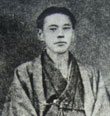
Chogoro Takayama is born to a sericulture family in Takayamamura, Joshu Province (Takayama, Fujioka City, Gunma Prefecture)
Image: Chogoro Takayama
Kenso Hayami is born in Kawagoe
Ryoichiro Arai is born to the Hoshino family in Mizunumamura, Joshu Province (Kurohone-cho, Kiryu City, Gunma Prefecture), and later adopted by the raw silk merchant Arai family in Kiryu
The Port of Yokohama opens due to the Treaty of Amity and Commerce between the United States and Japan, and raw silk from Japan becomes the top export item that traders from the West battle to purchase
Jubee Nakaiya becomes a founder and a world leader of the raw silk trade to coincide with the opening of the Port of Yokohama
The Raw Silk Export Inspection Office is established on Honmachi-dori Street in Maehashi to inspect raw silk and eliminate low-quality goods as a result of mass production
Zenzaburo Hara establishes the raw silk export business Kameya in Yokohama and builds a fortune
Yahei Tajima establishes the seiryo-iku method and builds a sericulture room, which becomes a model for modern day sericulture farmers
Zentaro Shimomura, a zaikata ninushi, starts trading overseas as a silk cocoon merchant in his hometown Maebashi
Tomitaro Hara is born
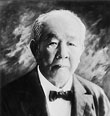
In February, to lay the foundation for encouraging new industry, the Meiji government focuses on the silk-milling industry as a means of obtaining foreign currency and decides to establish a Western-style mechanized silk mill
Comte Sallier de La Tour, the Italian Envoy Extraordinary and Minister Plenipotentiary to Japan and F. O. Adams, Secretary at the British Legation, undertake an inspection tour of sericulture regions and encourage the Meiji government to build mechanized silk mills
Hirobumi Ito, Eiichi Shibusawa and others decide to create a mechanized silk mill funded by the Japanese government
Frenchman Paul Brunat is invited to visit the regions of Nagano, Gunma, and Saitama. As a result, the decision is made to build a modern silk mill in Tomioka, Gunma Prefecture
Junchu Odaka protests changes made by local authorities regarding water supply for agricultural purposes and resolves the issue by petitioning to the government. This action brings him to the attention of high-ranking government officials and he is subsequently recruited to serve the new government
Image: Eiichi Shibusawa
On feudal orders, Kenso Hayami opens a business in Yokohama wholesaling raw silk for export. He learns about silk-milling machine technology from Casper Müller of Switzerland and establishes the feudally-run Maebashi Silk Mill, the first mechanized silk mill in Japan
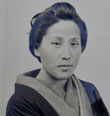
Government-run Tomioka Silk Mill is opened
Yu, the daughter of the first factory manager Junchu Odaka, and others join the factory as “factory girls” of their own initiative in July. There are four grades of “factory girl” – third through first grade and non-graded
On October 4, operations commence at the Tomioka Silk Mill
Yahei Tajima announces Yosan-Shinron (“A New Theory of Sericulture”)
Under the recommendation of Eiichi Shibusawa, Yahei Tajima participates in establishing Shimamura Kangyo Kaisha with a group of like-minded associates for the purpose of producing and selling high-quality silkworm eggs
Railway line opens between Shiodome and Yokohama
Image: Yu Odaka
By April, the total number of “factory girls” reaches 556. From 1873 to 1879, 26 silk mills all over Japan introduced a “Tomioka-style” method of mechanized silk milling similar to that of the Tomioka Silk Mill
Start of the Vienna World’s Fair. Tomioka’s raw silk is highly rated, and the name “Tomioka Silk” echoes around European countries.
Eiichi Shibusawa is given the mandate of compiling a book on sericulture and pens Sanso Shusei (“Collection of Knowledge on Silkworms and Mulberries”)
Chotaro Hoshino establishes the Mizunuma Silk Mill, a Western-style mechanized silk mill, and ships a large volume of raw silk
The “factory girl” grade system is revised to eight grades, exceptional non-graded, and seventh through first grade
Zenzaburo Hara and others establish the Second National Bank in Yokohama.
In the next two years, branches of the bank in Takasaki and Maebashi are set up
Matsugaoka Kaikonjo, a facility with the same type of sericulture rooms as the Tajima Yahei Sericulture Farm is built in present-day Tsuruoka City, Yamagata Prefecture
Zentaro Shimomura exports silkworm eggs overseas, and contributes to preserving quality of raw silk
Chotaro Hoshino sends his brother, Ryoichiro Arai, only 20 years old, to New York, where they materialize Japan’s first direct raw silk exports
Kuzo Kimura establishes the Sericulture Improvement Kyoshin-gumi
Christianity spreads in Shimamura (Sakaishimamura, Isesaki City), a community producing silkworm eggs
Annaka Church is established
Parishioners from the Annaka Church found the Kanra Church near Tomioka Silk Mill.
A school for the “factory girls” is set up by 1878
Maebashi’s Raw Silk Export Inspection Office becomes white incorporating Western-style architectural features
Yahei Tajima announces Zoku Yosan-Shinron (A New Theory of Sericulture II) and it is highly acclaimed together with his Yosan-Shinron (“A New Theory of Sericulture”) as an empirical research book.
It goes on to influence many silkworm egg farming families and sericulture farming families
Yahei Tajima goes overseas with silkworm eggs (silkworm-egg papers) accompanied by two employees of Shimamura Kangyo Kaisha, and engages in direct exports to Italy
Kenso Hayami is appointed the third factory manager of Tomioka Silk Mill
“Tomioka Silk” receives tremendous praise at the Melbourne International Exhibition
In March, Kenso Hayami resigns as factory manager of Tomioka Silk Mill and establishes Yokohama Doshin-Kaisha and puts his efforts into direct exports of raw silk
As the initial line of Japan’s primary private railway (Nippon Railway), the Takasaki Line commences provisional operation between Ueno and Kumagaya
Takasaki Line commences full operation the following year. It is established to transport raw silk and silk fabric to Yokohama by rail
The opening of Nippon Railway’s Honjo Station helps Honjo become a cocoon market boasting the largest trading volume nationwide
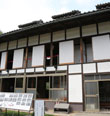
Kuzo Kimura reorganizes Sericulture Improvement Kyoshin-gumi as Sericulture Improvement Kyoshin-sha
Chogoro Takayama establishes Takayama-sha
The Ryomo Line opens between Takasaki and Maebashi as an extension of the Takasaki Line, for the purpose of transporting raw silk
Parishioners from the Annaka Church found the Kanra Church in Minamigokamura (Minamigoka, Tomioka City)
Image: Takayama-sha
America occupies 50 percent of raw silk exports
Kenso Hayami becomes the fifth Tomioka Silk Mill factory manager, and continues in his role until its privatization 8 years later
The Meiji government plans to build Western-style brick buildings in the government office district of the Hibiya area of Tokyo and requests that Eiichi Shibusawa establish a brick manufacturing factory. Shibusawa selects Joshikimen Village in Fukaya as the factory site
The Matsugaoka Silk Mill is established in present-day Sakata City, Yamagata Prefecture. The first-grade “factory girls” from the Tomioka Silk Mill are invited to teach there and trainees are sent to Yahei Tajima
Nihon Renga Seizo KK is established in Joshikimen Village. An office and Hoffman Kilns are constructed and operations commence
Bricks made by Nihon Renga are used in the structures such as Tokyo Station, the Bank of Japan building, and the Akasaka Palace
Kanra Church’s chapel is moved close to the main gate of Tomioka Silk Mill
Takayama-sha’s main building with sericulture rooms and training facilities are established
Raw silk made by Usui-sha is honored with a prize at the Chicago World’s Fair and a Japanese silk craze sweeps the globe
Tomioka Silk Mill is privatized, with Takayasu Mitsui winning the bid
From this time until 1902, the original silk reeling machines are replaced with a new type, and raw silk designated for export to the United States is produced
Kuzo Kimura establishes Kyoshin-sha Sericulture School
Kozuke Railway (present-day Joshin Electric Railway) is established, and two years later full operation commences between Takasaki and Shimonita
Kozuke Railway opens Joshu-Tomioka Station
The former Shibusawa residence (Nakanchi) is built in Fukaya
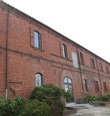
Old Brick Warehouse of the Commercial Bank of Honjo is built in Honjo to store raw silk and cocoons
Image: Old Brick Warehouse of the Commercial Bank of Honjo
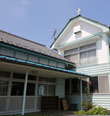
The United Church of Christ in Japan, Shimamura Church is built near the Tajima Yahei Sericulture Farm
Image: Shimamura Church
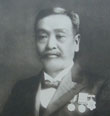
Kikujiro Machida establishes Takayama-sha Sericulture School
Image: Kikujiro Machida
Tomioka Silk Mill is acquired by Hara Gomei-Kaisha and management is taken over by Tomitaro Hara who designed a Japanese garden called Sankeien. During the Hara GMK era, the mill adopts the Minorikawa multiple-spool silk-reeling machine, invented by Naosaburo Minorikawa at the end of the Meiji period. This leads to improved quality of raw silk and greater productivity
The former Kameyama Silk Mill Muroyama Factory in Yokkaichi City, Mie Prefecture, modeled after Tomioka Silk Mill, is destroyed in a fire. It is rebuilt in 1903 and continues operations until 1995
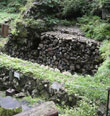
Seitaro Niwaya begins construction of Arafune Cold Storage and continues into the Taisho era as a silkworm egg storage facility
Image: Arafune Cold Storage
America occupies 70 percent of raw silk exports
The Yokohama Railway (Yokohama Line) opens between Hachioji and Yokohama
Japan becomes the world’s number one exporter of raw silk, accounting for 80 percent of the world market share
A group led by the chairman of the US Silk Industry Association comes to Japan and visits Gunma
Tobu Railway operation extends to Isesaki
The Sakai Red Brick Storehouse, used for storing cocoons, is constructed in front of Sakaimachi Station (currently Isesaki City) on the Tobu Line
The Shimonita Storehouses are two brick storehouses built in 1921 and 1926. The storehouses are used for storing cocoons purchased from farmers. Cocoons are then shipped by rail
All lines of Kozuke Railway are modified to electric operation
The Hachiko Line commences full operation, made to transport raw silk and silk fabric from Takasaki to Hachioji
Katakura Seishi Boseki takes over management of Tomioka Silk Mill
Ryoichiro Arai passes away at his home in Connecticut at the age of 84
In honor of his passing, the New York Board of Trade holds a moment of silence, and in his obituary, the New York Times honors him as the “founder of the Japanese-American raw silk trade”
The Hara Silk Mill (later the Hara Wataruse Silk Mill) in Watarusemura (currently Kamikawa-machi) becomes Japan Mica’s factory for manufacturing mica for insulators
The Maebashi branch of the Bank of Japan opens in Maebashi, showing evidence of how Maebashi is an important financial center
Kanra Church’s chapel is built using Oya stone in its current location
Nihon Renga’s Hoffman Kilns are used up to 1968
Tomioka Silk Mill achieves the highest production volume (over 370,000 kilograms) of any time in its history. In the peak production period the Nissan HR-type automatic silk-reeling machine is used
With its role fulfilled, Tomioka Silk Mill closes its doors after 115 years
Katakura Industries’ last silk milling factory, the Kumagaya Factory, continues operations until 1994
Kyoshin-sha changes its name to Kodama Farming School, then Kodama Agricultural High School before finally settling on Saitama Prefectural Kodama Hakuyo High School
Using the Kumagaya Factory of Katakura Industries’ cocoon warehouse, the Katakura Silk Commemorative Museum is established
The museum preserves and passes on the history of Katakura Industries’ more than 120 years in the silk industry
Nihon Renga continues operations until 2006
Annaka General Academic High School opens descending from Annaka Vocational High School, and Gunma Prefectural Silk High School
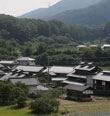
A group of sericulture farmhouses called Takamado-no-Sato in Higashi Kodaira, in the Akihira district, Honjo City are awarded a Saitama Prefecture Scenery Prize
Image: Takamado-no-Sato
The relationship between Eiichi Shibusawa and Junchu Odaka leads to Fukaya City and Tomioka City establishing a friendship-city relationship
On June 21, “Tomioka Silk Mill and Related Sites” are designated as World Heritage Sites at the 38th session of the UNESCO World Heritage Committee in Doha
Three structures—Tomioka Silk Mill’s reeling hall, east cocoon storehouse, and west cocoon storehouse—are designated as national treasures
Joshin Electric Railway’s Joshu-Tomioka Station, the gateway to Tomioka Silk Mill, undergoes large-scale renovation and repair.
Receives both the Good Design Award and the Architectural Institute of Japan Prize